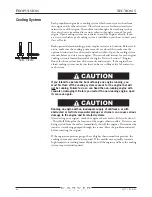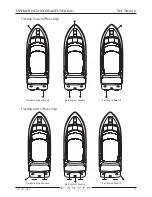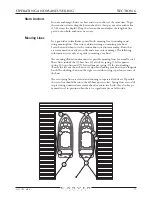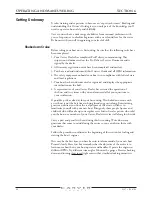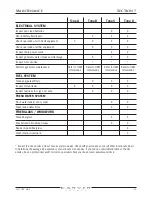
70
3327 • P2 6/06
PROPULSION
SECTION 5
Preparing for Cruising
Follow the steps below to safely fuel your boat and operate its engines.
Fueling
1. Make sure that your boat is securely moored.
2. Close all portlights, windows, hatches, and doors.
3. Turn “OFF” all devices that could create a spark, including fans, motors, the
galley range, and the generator.
4. Extinguish all open flames and smoking material, such as cigarettes, on the
boat and in the area around the fuel dock.
5. Turn all battery master disconnect switches to the “OFF” position.
6. Have all guests and passengers leave the boat. Only the fuel handlers should
be in the area.
7. Estimate the amount of fuel you wish to take on.
8. Select the fuel tank you wish to fuel first.
9. Remove the appropriate fuel fill deck plate (GAS or DIESEL) using the cap
removal tool supplied with your boat. The deck plates are located on top of
the weatherboards on either side of the cockpit. Refer to Section 9 - Deck
Plates for the exact locations of these plates.
While fueling, keep the fuel hose nozzle in constant contact with the
metal fuel fill fitting. This is a safeguard against static electricity that
could ignite any fuel vapor and cause an explosion.
You must use the correct fuel for your boat’s engines. Refer to the
engine OEM information for the recommended type of fuel.
Avoid spilling fuel on the gelcoat surface of your boat. Fuel can stain the
gelcoat and damage the hull accent stripes.
10. Your boat’s fuel tanks are designed to take on fuel at a maximum rate of 9
gallons per minute (GPM) when the tank is between 25% and 75% full.
During this time the pressure inside the tank must not exceed 4 psi. Be aware
that many marine fuel pumps can deliver fuel at rates up to 35 GPM. This
high fueling rate should never be used with your boat as it could damage your
fuel system.
When fueling a tank that is either nearly empty or nearly full, decrease the
fueling rate. This helps prevent fuel surge when the tank is empty, and back-
up and spillage when the tank is full.
Begin pumping fuel into the fuel tank at a rate of no more than 9 GPM.
When the tank is close to full, slow the fuel rate to less than 9 GPM.
Summary of Contents for 380 SPORT
Page 1: ...HIN CDR _________________ 380 Sport Owner s Guide 2007 Version 1 ...
Page 2: ......
Page 4: ......
Page 6: ......
Page 8: ......
Page 28: ......
Page 40: ...28 3327 P2 6 06 DC ELECTRICAL SYSTEM SECTION 2 DC SCHEMATIC 3327 324 002 5 12 7 05 ...
Page 54: ...42 3327 P2 6 06 AC ELECTRICAL SYSTEMS SECTION 3 AC SCHEMATIC 3327 300 015 2 9 04 ...
Page 108: ......
Page 122: ......
Page 124: ...112 3327 P2 6 06 WARRANTY AND PARTS SECTION 9 Hatches ...
Page 129: ...3327 P2 6 06 117 WARRANTY AND PARTS SECTION 9 Bill of Material ...
Page 130: ......
Page 131: ...3327 P2 6 06 119 WARRANTY AND PARTS SECTION 9 Carver Limited Warranty ...









